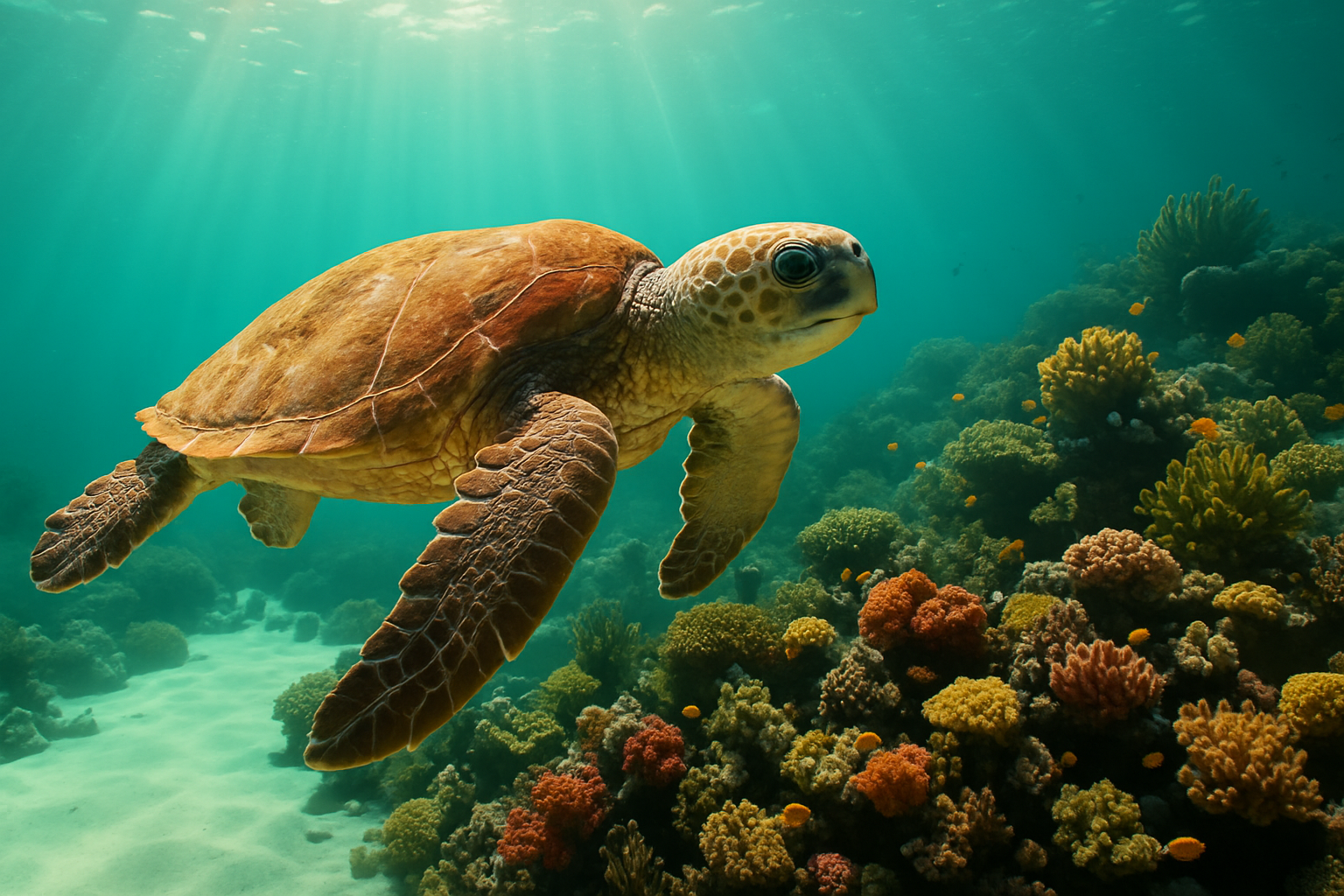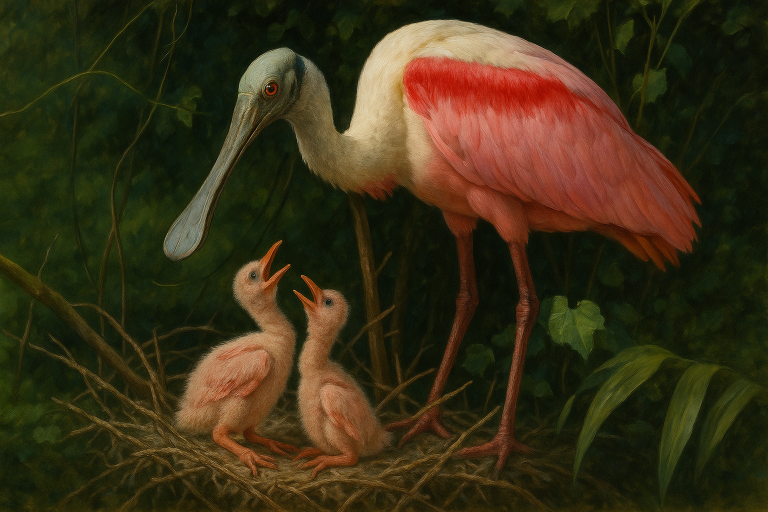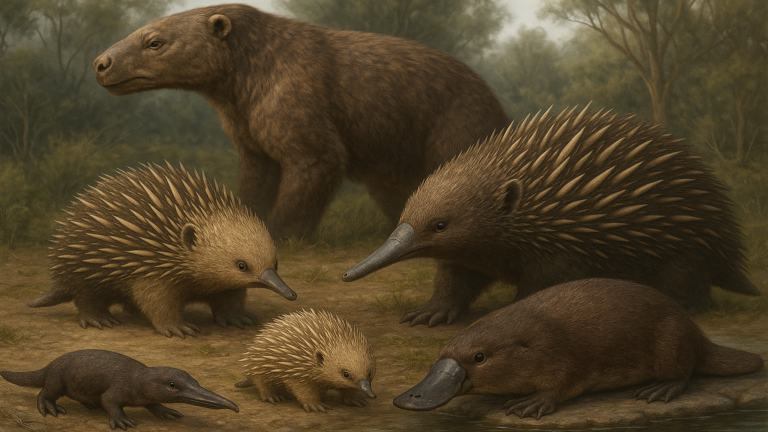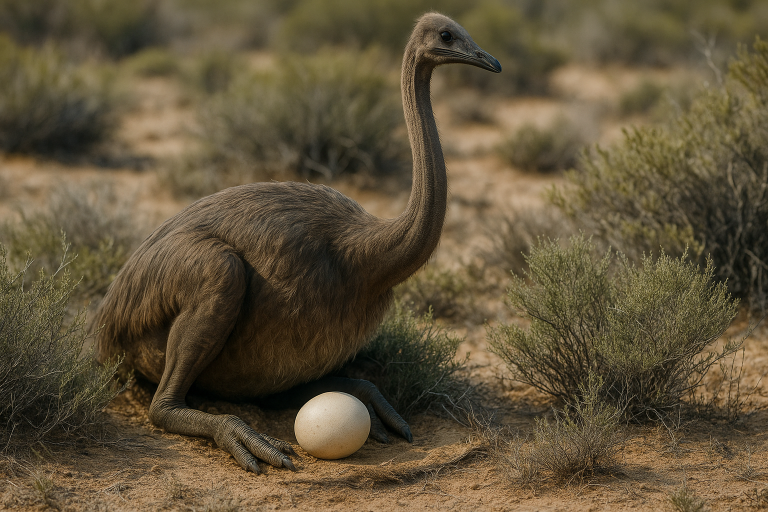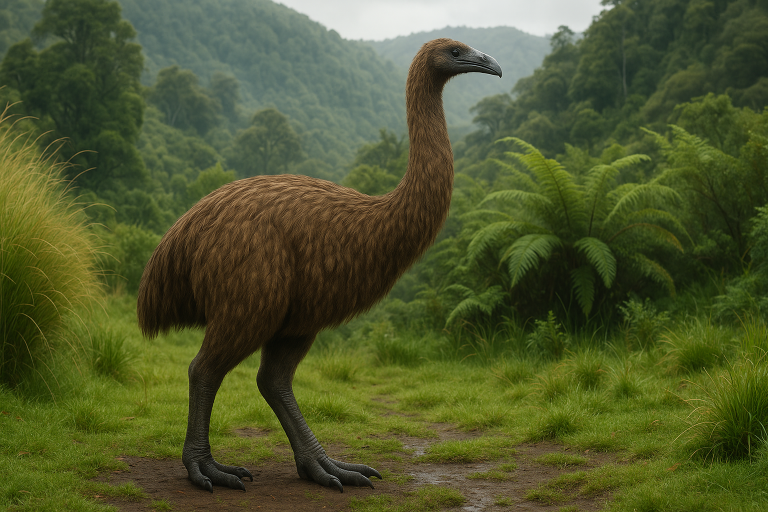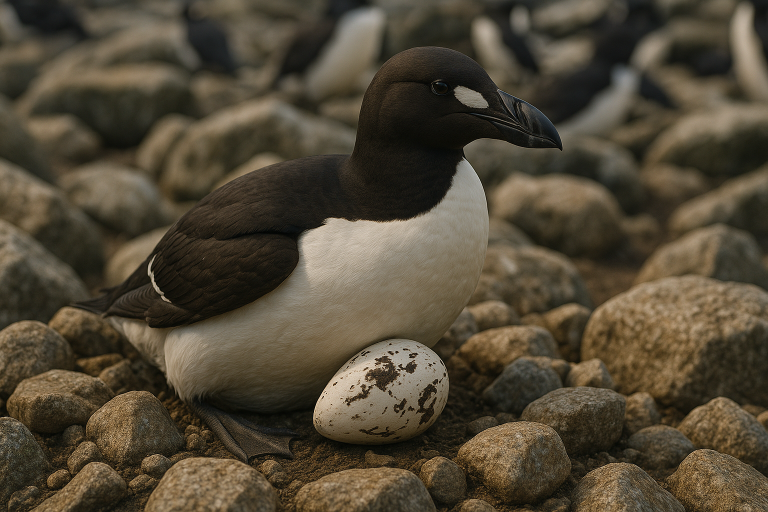The Biology of Sea Turtle Eggs
Sea turtles, from the petite hawksbill to the mighty leatherback, all begin their lives as eggs buried beneath warm beach sands. Despite variations among species, they share common reproductive traits. Females come ashore to lay soft, leathery eggs in carefully dug nests, then return to the sea, leaving the next generation to develop and fend for itself. This article explores the fascinating biology of sea turtle eggs; their form, how and where they are laid, how they incubate, and the perilous journey of hatching with examples from loggerhead, green, leatherback, and hawksbill turtles, among others.
Egg Morphology: Form and Differences
Sea turtle eggs are quite different from a chicken’s egg. They are round, ping-pong ball-sized or slightly larger, and unlike the hard, brittle bird eggshell, a turtle egg’s shell is flexible and leathery. This pliable structure, consisting of a thin calcareous layer of largely calcium carbonate in the form of aragonite over a soft shell membrane, allows eggs to withstand being dropped into a nest and jostled without cracking. When first laid, the eggs are coated in a thick, clear mucus that helps prevent them from drying out. This coating gradually dries as the eggs incubate in the sand. The eggs are white in color and lack pigmentation, an adaptation common to many reptile eggs that are buried out of sight.
Size and shape
All sea turtle eggs are roughly spherical, but their size varies by species. For example:
- Loggerhead (Caretta caretta): eggs ~4.0 cm in diameter (about the size of a ping-pong ball).
- Green turtle (Chelonia mydas): slightly larger, around 4.3–4.5 cm (comparable to a golf ball).
- Leatherback (Dermochelys coriacea): the largest sea turtle eggs, averaging ~5.3 cm in diameter (similar to a billiard cue ball).
- Hawksbill (Eretmochelys imbricata): among the smallest eggs, roughly 3.8 cm across and about 28 g in weight.
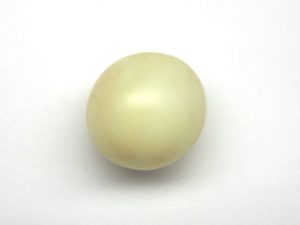
Loggerhead Sea Turtle
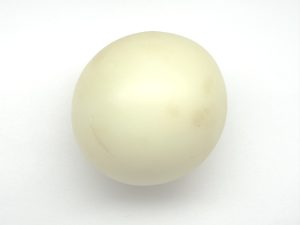
Leatherback Sea Turtle
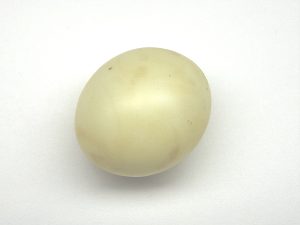
Green Sea Turtle
Despite these size differences, all sea turtle eggs share the same basic structure and a soft, parchment-like shell texture. The flexible shell not only cushions the eggs during laying, but also permits gas exchange. It is porous enough to allow oxygen in for the developing embryo and carbon dioxide out.
Shell composition
The eggshell is composed of a thin outer layer of calcium carbonate crystals and an inner fibrous membrane. Unlike bird eggs, which have thick, rigid calcium carbonate shells, a sea turtle’s eggshell feels leathery or rubbery. This unique composition serves an important purpose: it prevents eggs from breaking when the mother turtle drops them into the nest chamber, where they might fall on top of each other. The soft shell can slightly deform and absorb shock, then resume its shape. Additionally, the porous, moist shell helps maintain the proper humidity around the embryo as it develops.
Species-specific quirks
One unusual aspect of leatherback turtle reproduction is the production of yolkless eggs. Leatherback females typically lay a number of small, unfertilized eggs, often grape-sized or smaller, in each clutch alongside the normal yolk-filled eggs. These yolkless eggs contain only albumen (“egg white”) and no embryo. Their purpose isn’t fully understood. They may be a byproduct of the reproductive process with no adaptive function but they are a regular occurrence in leatherbacks, whereas other sea turtle species very rarely produce such infertile eggs. In all species, the vast majority of eggs a turtle lays are normal, fertile eggs capable of developing into hatchlings. In healthy nests, fertility rates often exceed 90%.
Nesting Behavior: Where and How Eggs Are Laid
All sea turtles nest on land, and the act of nesting is an elaborate and crucial part of their life cycle. A female turtle typically returns to the region of her own birth (her natal beach) to lay eggs, often exhibiting remarkable site fidelity by nesting on the very same beach where she hatched decades earlier. Nesting habits vary by species, but certain behaviors are common to most sea turtles:
Choosing the nesting site
Females emerge from the ocean, usually at night under cover of darkness, to avoid predators and heat. They crawl above the high-tide line on a sandy beach, often favoring areas with the right sand texture and temperature for incubation. Most species seek open sand or dunes, and hawksbill turtles in particular often prefer spots under or near vegetation at the beach edge. The cover of vegetation can help keep hawksbill nests slightly cooler and moister, since their egg chambers tend to be a bit shallower than those of other turtles. Leatherback turtles, being the largest species, need wide, unobstructed beaches with soft sand; they often nest on continental shores or large islands with deep sands, sometimes even in cooler climates or seasons where other turtles might not venture.
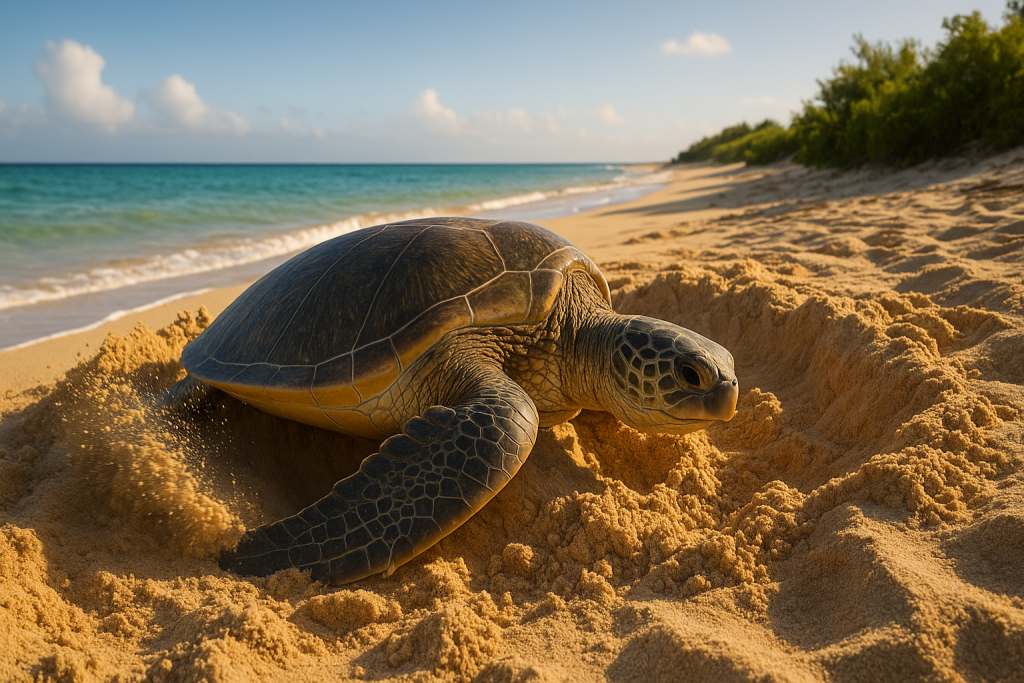
Green Sea Turtle beginning nest excavation
Timing
The majority of sea turtles nest during the warmer months of the year. In places like the southeastern United States, nesting season typically runs from about May through August. However, there are notable exceptions. Leatherbacks often begin nesting earlier or continue later than other species. For instance, they have been known to nest in cooler seasons (as early as February or into the fall months, depending on the region). Most turtles nest at night, when the beach is cooler and predators are fewer. Only a few species routinely nest in daylight. Kemp’s ridley and olive ridley turtles famously come ashore in massive synchronized groups called arribadas (Spanish for “arrivals”) during daylight hours. Hawksbills generally nest at night like other sea turtles, but in certain parts of the world, such as some Western Indian Ocean beaches, they have also been observed nesting during the day. Daytime nesting is possible for these smaller species partly because their lighter-colored shells may help avoid overheating in the sun, and their smaller size makes them slightly less conspicuous to predators on the beach.
Nest construction
Once a suitable spot is found, the female uses her front flippers to clear away dry surface sand, creating a shallow “body pit” where she can position herself. Then using her rear flippers as scoops, she digs a vertical egg chamber in the sand. This chamber is typically flask-shaped: narrow at the top and wider at the bottom, and can be up to about 0.5 to 1 meter (1–3 feet) deep depending on the species and the length of her hind flippers. The sand in the egg chamber is damp and cool, providing a stable environment for the eggs. Once the chamber is dug, the turtle begins laying eggs. She enters a trance-like state while laying, during which she is largely oblivious to disturbance. Eggs are laid a few at a time, falling into the chamber. Because the shells are soft and flexible, the eggs can drop and stack without breaking, even as the clutch grows large.
Clutch size
The number of eggs laid in a single nest (a clutch) varies widely among species, and even among individuals of the same species. On average, sea turtle clutches range from roughly 50 to 150 eggs. Flatback turtles (Natator depressus, found in Australia) lay the fewest; usually around 50 eggs per nest. Hawksbill turtles tend to lay some of the largest clutches; a hawksbill clutch averages about 130 eggs and can sometimes exceed 200 eggs. Loggerheads average roughly 100–125 eggs per nest, and green turtles around 100–120 eggs on average. Leatherback turtles lay about 50–100 sizable eggs per clutch, often accompanied by a few dozen smaller yolkless eggs as noted earlier. Despite laying fewer eggs than some smaller species, leatherbacks invest in larger eggs and often larger hatchlings. Each species has evolved its own reproductive strategy balancing egg size and egg number to maximize the chances that some offspring will survive.
Repeating the process
A single female does not lay just one nest and call it a season. During a nesting season, a female will typically nest multiple times laying several clutches at roughly 2-week intervals. A loggerhead or green turtle, for example, might nest 2 to 6 times in a season, while some ridleys and hawksbills may nest even more frequently, up to 8–10 clutches in a season in exceptional cases. Between nesting events, the turtle returns to the sea to forage and replenish energy. Remarkably, females often produce all the eggs for an entire season from stored sperm obtained from mating prior to the first nest. They can fertilize successive clutches without mating again in between, by storing viable sperm in their oviducts. After a full season of nesting, females usually take a break of a year or more. Most sea turtles do not nest every year. They typically skip one or two years and sometimes more before returning to nest again, allowing time to rebuild body reserves.
Covering and camouflaging the nest
Once the last egg is laid, the mother turtle uses her rear flippers to push sand back into the egg chamber, carefully packing it over the eggs. She then uses her front flippers to throw sand around, disguising the exact location of the nest. This camouflaging process helps hide the eggs from predators. Burying the eggs also serves to keep the soft shells moist and at a stable temperature, which is critical for embryo development. After the nest is thoroughly covered and the site looks as natural as the surrounding sand, the female turtle laboriously crawls back to the ocean. At this point her parental duties are complete – sea turtles do not guard their nests or care for their eggs/hatchlings at all. The entire nesting process, from emerging from the sea to returning, can take an adult turtle 1 to 2 hours and sometimes longer for first-time nesters or very large turtles. By dawn, usually no sign of the turtle remains, only a well-hidden nest beneath the sand. Experienced researchers or conservationists can sometimes identify the species of turtle that nested from the tracks and the distinctive pattern of the disturbed sand. For instance, different species leave characteristic flipper marks and body pits.
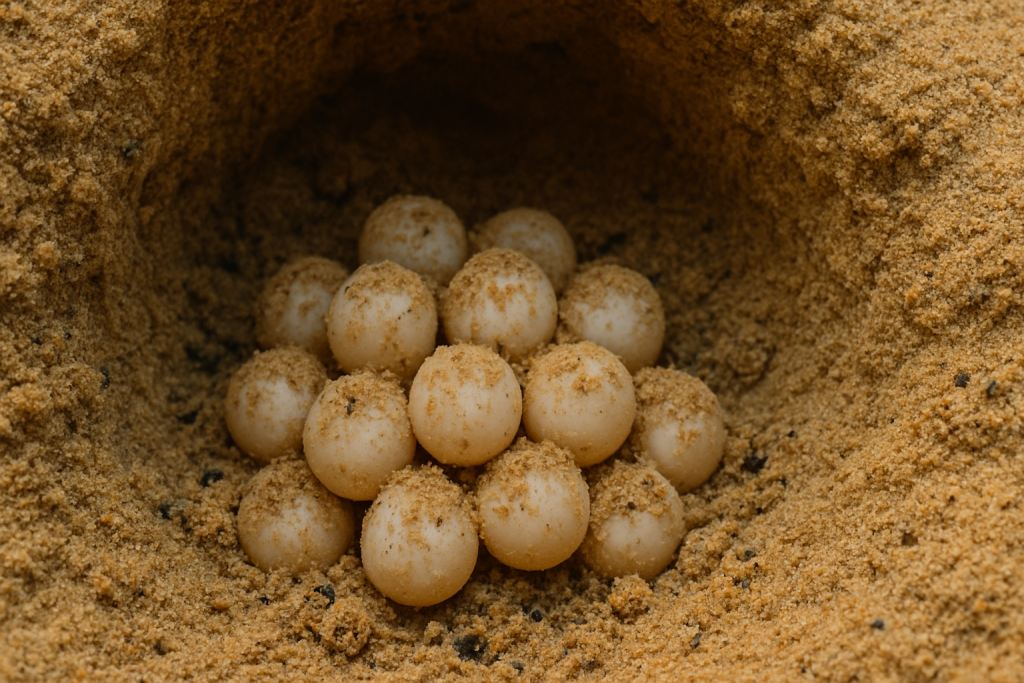
Incubation: Development Under the Sand
Once the eggs are safely buried, they enter the incubation phase. For the next several weeks, the developing embryos rely entirely on the nest environment for their survival. Incubation time varies somewhat by species and particularly by temperature, but generally it takes about two months for sea turtle eggs to hatch. A typical range is roughly 45 to 70 days from laying to hatching under natural conditions. Warmer nests tend to hatch more quickly, while cooler nests take longer. For example, in warmer beach climates or during hot weather, eggs might hatch in as little as ~45–50 days; in cooler conditions, they might take 60 days or even a bit more. If nest temperatures are very cool and near the lower limit at which embryos can develop, incubation can extend beyond 70 days, though such prolonged incubation can be risky for the embryos. Conversely, extreme heat can cause eggs to develop too rapidly or succumb before hatching. Generally, each species has an optimal temperature range for successful development, often around 25–33 °C (77–91 °F).
Temperature and sex determination
One of the most extraordinary aspects of sea turtle biology is that the temperature of the incubating eggs determines the sex of the hatchlings. This phenomenon is called temperature-dependent sex determination (TSD). Unlike humans and most mammals (which have genetic sex chromosomes), sea turtles have no sex chromosomes. Instead, the nest’s thermal environment during the middle third of incubation is the key factor that directs gonadal development toward male or female. In general, cooler sand produces more male turtles, and warmer sand produces more females. There is typically a “pivotal temperature”, usually around ~29 °C for many sea turtle species, at which a roughly 50:50 male-to-female ratio is produced. Studies on green turtles have shown that if the nest’s temperature stays around 28 °C (82 °F) or below, the hatchlings will be mostly male, whereas at 31 °C (88 °F) or above, the hatchlings will be predominantly female. Temperatures in between yield a mix of sexes. Each species and nesting beach may have its own precise pivotal temperature and transition range, but the pattern of cooler equals males and warmer equals females holds true broadly. This means that even a few degrees’ difference in sand temperature can skew the sex ratio of a nest. With climate change and warming global temperatures, many beaches are seeing a trend toward more females being produced, raising concerns about future breeding populations. Conservationists sometimes take measures like shading nests or relocating eggs to cooler spots to ensure a more balanced sex ratio.
Moisture and rainfall
The moisture content of the sand is another important factor. Eggs need a moist incubation environment but not soaking wet. Slightly damp sand helps prevent the eggs from drying out and also buffers temperature fluctuations through evaporative cooling. If a nest is in sand that is too dry, the eggs can lose too much water and the embryos may dry out before they fully develop. On the other hand, if a nest gets flooded with water e.g. due to heavy rains, extreme high tides, or inundation from surf, the embryos can drown because they cannot get enough oxygen. Sea turtle embryos breathe air through a special membrane inside the egg, drawing oxygen from air pockets in the sand. They cannot survive if the egg is continuously submerged in water. That’s why females instinctively choose nesting spots that are above the high tide line and have well-drained sand. Moderate rainfall can be beneficial by cooling overly hot nests and keeping sand appropriately moist, but excessive rain or poor drainage spells trouble. Research on loggerhead and green turtle nests has shown that both too dry and too wet conditions reduce hatching success. Ideal nest moisture lies in a middle range. Enough to sustain embryo hydration and allow gas exchange, but not so much that the sand becomes waterlogged. Interestingly, moisture can interact with temperature effects. Wetter sand cools more slowly and can keep nests a bit cooler during hot periods due to water’s thermal properties and evaporation, potentially influencing hatchling sex ratios in subtle ways.
Sand type and beach characteristics
The physical qualities of the sand such as grain size, color, and compaction also influence incubation. Sand color matters because darker sands absorb more solar radiation and heat up faster, potentially raising nest temperatures. For example, volcanic or mineral-rich dark sands can produce warmer nests and thus more female hatchlings compared to white coral sands under the same sun exposure. The thermal conductivity and heat capacity of the sand determine how heat is transferred to the nest. Coarse or loosely packed sand might allow more air flow and therefore potentially cooler nests, whereas very fine or dense sand can retain heat longer. If a beach has been artificially nourished by adding sand from elsewhere, the introduced sand might have different thermal properties. Often, nourished sections of beach have been found to be slightly warmer (on average ~0.4°C higher) than natural sections. Sand grain size and compaction also affect gas exchange and the ease with which hatchlings can emerge. Very compacted or clay-heavy sand can trap eggs or make it harder for hatchlings to dig out. This is one reason why sea turtles typically choose sandy, well-aerated soils rather than muddy or compact ground. In some cases, if beach sand is too compact or of the wrong consistency such as from coastal engineering projects, turtles may even reject the site or have trouble digging nests properly. Hawksbill turtles, as noted, often nest under vegetation. One benefit of this behavior may be that the shaded sand is cooler and the roots can create air pockets that improve drainage and incubation conditions in the upper nest layers.
Incubation success and extremes
Under optimal conditions, a very high percentage of eggs in a nest are capable of hatching. In undisturbed, healthy nests, often over 90% of the eggs hatch successfully. However, various stressors can lower this success rate. If temperatures rise too high, beyond about 34–35 °C for prolonged periods, many embryos may not survive to hatch, essentially cooking in the sand or suffering developmental abnormalities. Conversely, if temperatures are too low, approaching the low 20s °C, development can stall or hatchlings can be weak and unviable. Nests that get flooded or invaded by fungi, bacteria, or insect infestations also see reduced hatching rates. Predators raiding the nest, such as raccoons or feral pigs digging up eggs, obviously devastate clutch success. Human disturbances, like people driving over nests with vehicles or construction on beaches, can crush eggs or alter sand conditions. For instance, Florida wildlife data show that when nests are disturbed by humans or predators, hatch success can plummet to 25% or even much lower. Thus, the sand cradle of a sea turtle’s eggs must maintain a delicate balance of temperature and moisture for roughly two months. During this time, the developing embryos gradually form into fully equipped baby turtles.
Hatching: Emergence, Hazards, and Survival of Hatchlings
After weeks of invisible growth under the sand, the moment of hatching arrives. Sea turtle hatchlings typically emerge from their nests in groups, in a marvel of coordination and teamwork. The hatching process doesn’t happen immediately when the first baby turtle breaks out of its shell. It can actually take several days from the initial hatching to the emergence of the group at the surface. Here’s how this final phase unfolds:
Breaking out of the shell
Inside the buried nest, the hatchlings use their temporary egg tooth (also called a caruncle) to slit open their leathery eggshells. Hatching is often synchronous; as one turtle starts to break free, the movement and noise stimulate others to hatch almost simultaneously. In a matter of a day or two, most eggs in the clutch will have hatched, filling the chamber with dozens of tiny turtles. At this point, the hatchlings rest for a short period, absorbing the last of their yolk sac for nutrition. They remain below the sand until conditions are right to emerge.
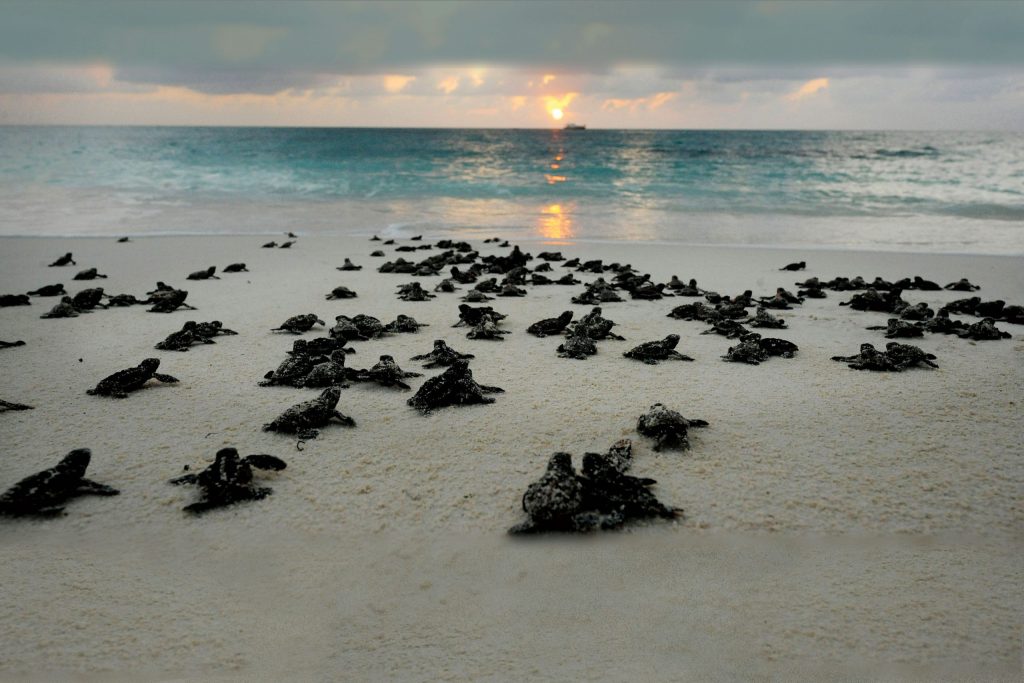
Group emergence
Sea turtle hatchlings almost always emerge en masse, or in a few large batches, rather than one at a time. Dozens of little turtles will boil out of the sand within minutes of each other. This is not a coincidence but rather is crucial for their survival. A solitary hatchling would find it nearly impossible to dig its way up through the column of sand alone. Imagine a creature the size of a baby turtle having to tunnel out of a 50 cm deep sand hole. Working together, the hatchlings agitate and aerate the sand, effectively “swimming” upward as a group. They climb over the piles of eggshells and push upward, often taking advantage of small gaps that form as each shell collapses. As the ones near the top scratch and loosen the sand, the others below them scramble upward over their siblings. This process can take a couple of days of intermittent effort. Eventually, the sand at the surface gives way and a hole opens up, often at night, out of which a cluster of baby turtles spills onto the surface. If the nest is undisturbed, all the hatchlings usually emerge together or over two or three consecutive nights and make a break for the sea simultaneously. Emerging in numbers helps swamp predators. A few might be caught, but many others can hopefully make it through. It’s essentially a safety-in-numbers strategy, where the probability of any one hatchling being eaten is lower when there are many peers around to distract predators. An isolated straggler from the nest would be an easy target for every nearby predator and stands little chance.
Timing of emergence
Hatchlings overwhelmingly prefer to emerge at night. This too is a survival strategy. Nighttime offers the cover of darkness from visual predators like birds, and the sand surface is cooler so the risk of overheating or drying out is reduced. If a nest hatches in daytime or the babies find themselves close to the surface in daylight, they often wait just beneath the sand until evening before crawling out. Sometimes, after particularly hot days, hatchlings will even emerge during a rainstorm because the rain-cooled sand triggers them to move. Studies have noted that some nests may produce hatchlings on multiple nights. For example, if a nest is large or if some hatchlings lag in getting out, you might see one group emerge one night and another group the next night. But typically, most of the clutch comes out in the first event.
Dash to the sea
Upon breaking out at the surface, hatchlings orient themselves and head quickly for the ocean. They have an inborn instinct to crawl toward the brightest, most open horizon. On a natural, undeveloped beach at night, the open ocean horizon reflecting starlight or moonlight is usually brighter than the dune or forest behind the beach, so the hatchlings scramble in that direction – which is fortunately towards the water. On the way, they imprint the unique magnetic signature of their home beach into their internal navigation system, an amazing mechanism that will help guide the females back decades later when it’s their turn to nest. The trek from nest to ocean is the most dangerous journey these baby turtles will ever undertake. They are under immediate threat from a gauntlet of predators: waiting seabirds can snatch them from the sand or even mid-swim in shallow water, ghost crabs on the beach may grab stragglers, and on some beaches raccoons, foxes, or feral dogs hunt hatchlings as they emerge. If the beach is wide, exhaustion or the morning sun can also be lethal. A hatchling that doesn’t reach the water by daylight might die of dehydration or heat exposure on the sand. Those that make it to the surf still face predation in the waves; fish and carnivorous marine creatures patrol the shallows for easy prey. The first 24–48 hours after reaching the sea, hatchlings engage in a frantic “swim frenzy,” continuously swimming to get away from nearshore waters and into the relative safety of the open ocean. During this frenzy, they often dive in response to threats. Hatchlings have been observed instinctively diving when gulls or even overhead shadows appear, hinting at an inherited anti-predator response. Eventually, the tiny turtles reach floating seaweed mats or currents that carry them offshore. They enter what is often called the “lost years,” where they drift and feed in the open ocean, largely unseen, until they are big enough to return to coastal areas as juveniles.
Threats to hatchlings
In addition to natural predators, modern sea turtle hatchlings face human-caused hazards. Artificial lighting from beachfront developments is a notorious problem: baby turtles can become fatally disoriented by lights from buildings, street lamps, or cars, which lure them inland or along the beach instead of toward the ocean. Hundreds of hatchlings can be lost to exhaustion, predation, or even traffic if they crawl the wrong way because of lights. To mitigate this, coastal communities in nesting areas often enforce lights-out policies during nesting season and promote “turtle-friendly” lighting. Other threats include beach debris, which can entrap or obstruct hatchlings, and pollution. For instance, tiny turtles can become ensnared in trash or ingest plastic bits even in their first days of life. Every additional obstacle further slim chances that a hatchling will survive.
Survival rates
The journey from egg to adult is so perilous that only a tiny fraction of hatchlings will survive to reproductive age. It’s often cited that only about 1 in 1,000 hatchlings will make it to adulthood. Some estimates are even more dire, suggesting it could be as low as 1 in 5,000 or 1 in 10,000 in certain environments. While exact figures are hard to pin down, the underlying truth is that the natural attrition is enormous. Sea turtles compensate for this by laying large clutches of eggs. From the moment they hatch, baby turtles face long odds. Over 90% may fall victim to predators within the first few days or weeks of life. Many others succumb to starvation, cold, or storms during their oceanic juvenile phase. Those that do grow into juveniles still contend with larger predators such as sharks and human threats like fishing nets and boat strikes. By the time a female turtle that hatched on a beach returns to that same beach to nest, which might be 20 or more years later for species like loggerheads or greens, hundreds or thousands of her original nest-mates will have perished. The rarity of survivors is why every nesting female is so biologically valuable to the population.
Encouragingly, if a turtle reaches adulthood, its chances improve significantly. Adult sea turtles have few natural predators, occasionally sharks or orcas, and can live for decades. But getting to that stage is truly a struggle for existence.
Natural vs. human impact
It’s worth noting that the 1-in-1000 type survival rate often includes the additive impact of human pressures. Naturally, sea turtles evolved with high hatchling mortality as part of their life history strategy. Predators like crabs and birds picking off young turtles is a normal occurrence and, in a balanced ecosystem, a certain small percentage would always survive. However, human activities have dramatically increased losses at every stage. Through habitat destruction, light pollution, bycatch in fisheries, egg poaching, and climate change which can cause nest failures due to overheating or swamping. These pressures mean that in many places even fewer than the natural baseline number of hatchlings are surviving today. This is why nearly all sea turtle species are now classified as threatened or endangered despite their ancient resilience.
Conclusion
From the soft, white ping-pong ball-like eggs hidden beneath the sand to the frenzied crawl of hatchlings toward the sea, the reproductive cycle of sea turtles is a story of adaptation and vulnerability. The small, leathery eggs are perfectly adapted to incubate in sand, reflecting millions of years of evolution. Each female’s nesting behavior, migrating vast distances to natal beaches, laboring under cover of night to bury her precious clutch, is a remarkable feat of instinct and endurance, with species-specific twists such as mass nestings or unique nesting sites. The incubation period shows how sensitive these animals are to their environment with temperature and humidity deciding not just how quickly eggs develop, but the very sex ratio of future generations. The moment of hatching encapsulates both hope and hazard. Many baby turtles emerging together, small but determined, face immediate threats on their race to the ocean. Their odds of survival may be slim, yet by sheer numbers and ancient ocean-going tenacity, some will survive to continue this life cycle.
Understanding the biology of sea turtle eggs and early life stages is not only fascinating science, it’s crucial for conservation. Knowing, for instance, that slight changes in sand temperature can skew sex ratios, or that artificial lights can fatally mislead hatchlings, allows us to take informed actions to protect these creatures. Around the world, volunteers and researchers patrol nesting beaches to relocate at-risk nests, shade them if needed, guard them from predators, and help hatchlings reach the sea. All in an effort to boost that tiny hatchling survival percentage just a bit higher. Sea turtles have survived on Earth for over 100 million years, and their eggs have hatched on sandy beaches long before humans ever walked those shores. With continued research and conservation efforts, we can ensure that these ancient mariners continue to bury their eggs in warm sands and send new tiny turtles seaward for generations to come.
References
- Sea Turtle Camp – “Sea Turtle Eggs.” Turtle Talk Blog, Feb 13, 2024. Describes the characteristics of sea turtle eggs (soft, leathery shells, sizes compared to ping-pong, golf, and cue balls) and notes average clutch size and incubation duration.
- Sea Turtle Conservancy – “Learning About Sea Turtles.” Comprehensive FAQ explaining sea turtle reproduction and early life, including clutch size variations by species, egg appearance (ping-pong ball size, soft shell), temperature-dependent sex determination, and the group emergence behavior of hatchlings.
- SeaWorld Parks & Entertainment – “All About Sea Turtles – Reproduction.” An educational resource detailing nesting behavior (night vs. day nesting differences, arribada in ridley turtles), typical clutch sizes for each species (e.g., hawksbill ~130, loggerhead ~122, etc.), and the nesting process of digging and covering nests.
- SeaWorld Parks & Entertainment – “All About Sea Turtles – Hatching & Care of Young.” Describes incubation duration (45–70 days), temperature effects on sex (example of green turtle pivotal temperatures), hatching process (use of egg tooth, 3–7 days to emerge), and hatchling behavior (night emergence, >90% success in undisturbed nests).
- Gnaraloo Wilderness Foundation – “The World of Science: Sea Turtle Eggs” (Field Diary 2018). Provides scientific details on egg size by species (loggerhead 4.0 cm, leatherback 5.3 cm, hawksbill 3.8 cm) and eggshell composition (flexible aragonite shell and membranes), as well as discussion of yolkless eggs and reproductive physiology.
- Florida Fish and Wildlife Conservation Commission (FWC) – “Sea Turtle FAQ.” Offers concise answers on nesting frequency (females nest every 2–3 years, laying ~80–120 eggs per nest), incubation (~2 months), hatchling emergence (all at once at night, imprinting on natal beach), and survival rates (~1 in 1000 survives, with many hatchlings preyed upon or dying of dehydration).
- Louisiana Sea Grant / NOAA – “Sea Turtle FAQs – LSU Sea Grant.” Notes that only about 1 in 1000 sea turtle hatchlings survive to maturity and that over 90% of hatchlings are eaten by predators, underscoring the low natural survival rate of baby sea turtles.
- SWOT Report (State of the World’s Sea Turtles) – Mortimer et al. “Hawksbills: The Most Beautiful of Sea Turtles.” Provides insight into hawksbill nesting habits (tendency to nest under vegetation and even in mangrove estuaries, relatively shallow nests) and notes unusual daytime nesting in certain regions.
- Thermtest Blog – “The Role of Sand’s Thermal Conductivity in Sea Turtle Survival.” Discusses how sand properties (thermal conductivity, color, moisture) influence nest temperature and thus incubation and sex determination, with references to how beach nourishment can alter sand temperature and how extreme nest temperatures affect hatching success.
- FAU Marine Laboratory – “Rain or Shine? How Rainfall Impacts Size of Sea Turtle Hatchlings” (press release). Indicates that environmental factors like sand temperature and moisture can influence hatchling development and size, emphasizing the role of rainfall and moisture in incubation (supporting the idea that moisture is critical for successful hatching). [FAU Press Release, 2020 – not directly quoted above but relevant].
(All inline citations refer to the specific sources listed above by their number. These sources provide the scientific data and observations that underpin the statements in the text.)

